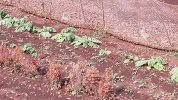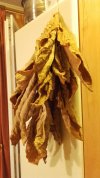Mr. Premise
The Living Force
Eärwen said:Thank you Mr. Premise.
I'm living in a southern Dalmatia (south end of Croatia's coast) and last five summers temperatures oscillated between 34-39,5 degrees Celsius. Last summer we had rain for seven times, but that is anomaly, most of the time Lovište, little village I'm living in don't have rain during the summer or it is just a few drops in five to six months. And there is problem with red karst soil, it is very light soil that evaporate moisture pretty fast. We decided to follow the traditional way of growing because it is only option in this climate condition. According to what I learned form farmers it is needed to water tobacco plants with 1/2 litre every day in the evening (two hours after the sun set) or two hours before sun rise because water must be cold and soil can't be hot from the sun because tobacco got sensitive roots. At first seven days tobacco needs to be watered every day in small quantities twice a day, and after that once a day with 1/2 litre of water.
Yeah that is a reason we'll like to start with relatively small amount, for the time being we do not know how the plants will react on our soil, manure and tap water, and of course we never did it by ourself. I'm a bit afraid of pruning, topping and curing but I am willing to learn.
I would gladly exchange seeds with you. I have Burley from Herzegovina (smaller leaves and darker colour, stronger taste) and Burley from central Croatia (nice meaty leaves and mild taste), central European variety of Golden Virginia (extra mild taste), and Virginia from Moslavina it has specific delicious mild taste and when cured strong 'golden' colour, and I'm pretty happy to gain seeds form old variety of Cuban mountain tobacco, excellent for cigars and cigarillos (strong big leaves and rich sweet taste), I have only 500 seeds of Cuban but I don't need more than couple seeds for this year.
Could you please tell me what kind of curring is your favourite and how you do it?Is there any difference in growing and watering of your respective tobacco (Virginia and Turkish) how do you prevent disease or treat them?
Thank you in advance. :D
Those varieties sound interesting, we can definitely trade seeds this winter.
As for curing, I usually do basic air curing. I have experimented with flue curing virginia tobacco, the results are great, but it can be a difficult process that needs monitoring, and I haven't had the time or the skills to build a decent sized flue curing chamber. The one time I did it I used a simple small-scale method using an insulated metal garbage can. The problem with flue curing is that you need to monitor the conditions and I travel for my job so that makes it hard. Flue curing results in a brighter, sweeter virginia leaf. The way it works is you put the green leaves in the chamber and raise the heat to 100 F (37C) at about 90-95% humidity for a few days or until the leaves yellow. Next is the wilting stage where you gradually raise the temperature to 118 F (48C) and vent the chamber so the moisture in the leaves can slowly escape until the humidity lowers to 51% (about 24 hours). Next comes the leaf drying stage where you raise the temps gradually to 135F (57C) and the humidity drops to 35%. The last stage is stem drying where you raise the temps gradually to up to 167F or 75C and the humidity drops to 17%. The whole purpose is to lock in the color and sweetness by drying it as fast as you can without scorching it or rotting it. But as you can see it can be tricky. The temps can't rise too fast, so you have to set the thermostat to raise it 1F per hour over a 24 hour period! People who have done it at home usually use an Anduino controller which can be programmed to do this. Anyway, I did do this one year with some success, but I had to throw away a fair amount of leaves that either dried green or got scorched. A better insulated chamber with good venting and a fan might help. But for now this is too big a project for me.
As I mentioned before, sun curing is better than air curing for Virginias but not as good as flue curing. Sun curing has the advantage of being quicker, too. Not as quick as flue curing which can be done in 8-10 days but much quicker than air curing which can take a month or more for the stems to dry. For Burley and Turkish, air curing is fine, although Turkish benefits from sun curing. This year I experimented with sun curing for some of the earlier pickings, but in my climate the nights get too cool in September and October and the leaves can get pretty wet at night which can be a problem when they are dry (except for the stem). But we had a dry and fairly warm fall here, so I was able to sun cure or partially sun cure a good portion of my crop before rains and frosts hit. We'll see how it turns out. But mostly I air cure then kiln ferment. I pick the leaves when they are ripe and string them on 17 gauge fence wire in my basement. There I can control the humidity. This is important because for curing there are two things to avoid. Drying green and mold. If the humidity is too low during the yellowing phase, the leaves can dry green making them useless. But if the humidity is too high once the leaves have dried, mold can set in. The way to avoid mold is to keep the air moving with fans. But if you run fans on leaves that haven't color cured, they can dry green. So this can be a problem when some leaves are almost cured while others have just been picked. What I did this year was put my partially dry sun cured leaf in one room in my basement where I could run a fan, and I put the fresh picked rest of the crop, picked all at once, in another room, where I could let them yellow without a fan which can cause green drying. In about a week they have yellowed and today I turned the fan on. But since it is getting cooler outside, I have been running a humidifier in that room to keep the humidity at around 60% until the leaves are completely yellowed. Then I can let the humidity get low, which it does in my basement when the temps outside get cold and the furnace runs.
Of course the traditional method is in barns or sheds. In the tobacco growing areas, which are warmer then where I live, you get high temps in barns in the day and at night high humidity. These barns will have lots of windows and vents so the growers can regulate the temperatures and humidity and get a good air flow.
Then one the leaves are completely dry you can either pack it up and store it for a year or two to age, but if you want to smoke it right away, you can speed up the process by fermenting it in a kiln. I use an old refrigerator with the compressor taken out, which makes it an insulated box, but you can build one from wood and insulation. The process is to keep the leaves at 70% humidity and 120-125 F (49-51C) for four weeks. What I found works best is to fill a plastic semi-sealed storage container with leaves, mist the leaves with some water, and put it in the kiln. to maintain the proper temperature, I use a crockpot connected to a thermostat. The leaves in the containers will dry out so you can spray some more water on it when that happens, you want them to be nice and pliable but not wet. That's basically what 70% humidity is. Then you can smoke it right away, usually about December. There are a few varieties that taste good with no aging or fermenting, but Burley will be too harsh and Virginia will have a grassy taste before it's aged properly.











